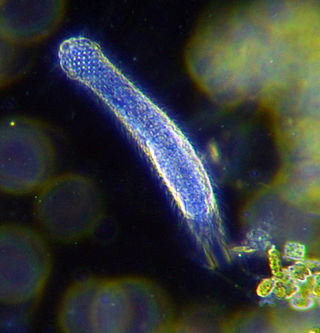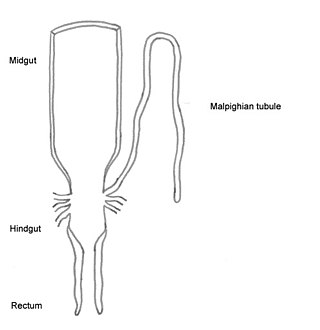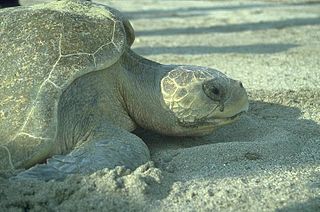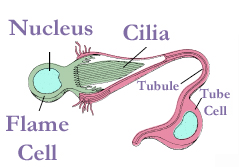
In humans, the kidneys are two reddish-brown bean-shaped blood-filtering organs that are a multilobar, multipapillary form of mammalian kidneys, usually without signs of external lobulation. They are located on the left and right in the retroperitoneal space, and in adult humans are about 12 centimetres in length. They receive blood from the paired renal arteries; blood exits into the paired renal veins. Each kidney is attached to a ureter, a tube that carries excreted urine to the bladder.

The gastrotrichs, commonly referred to as hairybellies or hairybacks, are a group of microscopic (0.06–3.0 mm), cylindrical, acoelomate animals, and are widely distributed and abundant in freshwater and marine environments. They are mostly benthic and live within the periphyton, the layer of tiny organisms and detritus that is found on the seabed and the beds of other water bodies. The majority live on and between particles of sediment or on other submerged surfaces, but a few species are terrestrial and live on land in the film of water surrounding grains of soil. Gastrotrichs are divided into two orders, the Macrodasyida which are marine, and the Chaetonotida, some of which are marine and some freshwater. Nearly 800 species of gastrotrich have been described.
The excretory system is a passive biological system that removes excess, unnecessary materials from the body fluids of an organism, so as to help maintain internal chemical homeostasis and prevent damage to the body. The dual function of excretory systems is the elimination of the waste products of metabolism and to drain the body of used up and broken down components in a liquid and gaseous state. In humans and other amniotes, most of these substances leave the body as urine and to some degree exhalation, mammals also expel them through sweating.

The nephron is the minute or microscopic structural and functional unit of the kidney. It is composed of a renal corpuscle and a renal tubule. The renal corpuscle consists of a tuft of capillaries called a glomerulus and a cup-shaped structure called Bowman's capsule. The renal tubule extends from the capsule. The capsule and tubule are connected and are composed of epithelial cells with a lumen. A healthy adult has 1 to 1.5 million nephrons in each kidney. Blood is filtered as it passes through three layers: the endothelial cells of the capillary wall, its basement membrane, and between the foot processes of the podocytes of the lining of the capsule. The tubule has adjacent peritubular capillaries that run between the descending and ascending portions of the tubule. As the fluid from the capsule flows down into the tubule, it is processed by the epithelial cells lining the tubule: water is reabsorbed and substances are exchanged ; first with the interstitial fluid outside the tubules, and then into the plasma in the adjacent peritubular capillaries through the endothelial cells lining that capillary. This process regulates the volume of body fluid as well as levels of many body substances. At the end of the tubule, the remaining fluid—urine—exits: it is composed of water, metabolic waste, and toxins.

Excretion is a process in which metabolic waste is eliminated from an organism. In vertebrates, this is primarily carried out by the lungs, kidneys, and skin. This is in contrast with secretion, where the substance may have specific tasks after leaving the cell. Excretion is an essential process in all forms of life. For example, in mammals, urine is expelled through the urethra, which is part of the excretory system. In unicellular organisms, waste products are discharged directly through the surface of the cell.
In biology, a tubule is a general term referring to small tube or similar type of structure. Specifically, tubule can refer to:

Fasciola hepatica, also known as the common liver fluke or sheep liver fluke, is a parasitic trematode of the class Trematoda, phylum Platyhelminthes. It infects the livers of various mammals, including humans, and is transmitted by sheep and cattle to humans all over the world. The disease caused by the fluke is called fasciolosis or fascioliasis, which is a type of helminthiasis and has been classified as a neglected tropical disease. Fasciolosis is currently classified as a plant/food-borne trematode infection, often acquired through eating the parasite's metacercariae encysted on plants. F. hepatica, which is distributed worldwide, has been known as an important parasite of sheep and cattle for decades and causes significant economic losses in these livestock species, up to £23 million in the UK alone. Because of its relatively large size and economic importance, it has been the subject of many scientific investigations and may be the best-known of any trematode species. F. hepatica's closest relative is Fasciola gigantica. These two flukes are sister species; they share many morphological features and can mate with each other.

The Malpighian tubule system is a type of excretory and osmoregulatory system found in some insects, myriapods, arachnids and tardigrades.
The nephridium is an invertebrate organ, found in pairs and performing a function similar to the vertebrate kidneys. Nephridia remove metabolic wastes from an animal's body. Nephridia come in two basic categories: metanephridia and protonephridia. All nephridia- and kidney- having animals belong to the clade Nephrozoa.

The mesonephros is one of three excretory organs that develop in vertebrates. It serves as the main excretory organ of aquatic vertebrates and as a temporary kidney in reptiles, birds, and mammals. The mesonephros is included in the Wolffian body after Caspar Friedrich Wolff who described it in 1759.
A nephridiopore is part of the nephridium, an excretory organ found in many organisms, such as flatworms and annelids. Polychaetes typically release their gametes into the water column using nephridiopores.
Metabolic wastes or excrements are substances left over from metabolic processes (such as cellular respiration) which cannot be used by the organism (they are surplus or toxic), and must therefore be excreted. This includes nitrogen compounds, water, CO2, phosphates, sulphates, etc. Animals treat these compounds as excretes. Plants have metabolic pathways which transforms some of them (primarily the oxygen compounds) into useful substances.

The coxal gland is a gland found in some arthropods, for collecting and excreting urine. They are found in all arachnids, and in other chelicerates, such as horseshoe crabs. The coxal gland is thought to be homologous with the antennal gland of crustaceans. The gland consists of an end sac (saccule), a long duct (labyrinth) and a terminal bladder (reservoir). There is generally only one pair, and they open on the coxae of the walking legs. The coxal secretion of adult female ticks of Ornithodoros erraticus contains a sex pheromone.
An apocrine sweat gland is composed of a coiled secretory portion located at the junction of the dermis and subcutaneous fat, from which a straight portion inserts and secretes into the infundibular portion of the hair follicle. In humans, apocrine sweat glands are found only in certain locations of the body: the axillae (armpits), areola and nipples of the breast, ear canal, eyelids, wings of the nostril, perineal region, and some parts of the external genitalia. Modified apocrine glands include the ciliary glands in the eyelids; the ceruminous glands, which produce ear wax; and the mammary glands, which produce milk. The rest of the body is covered by eccrine sweat glands.

The salt gland is an organ for excreting excess salts. It is found in the cartilaginous fishes subclass elasmobranchii, seabirds, and some reptiles. Salt glands can be found in the rectum of sharks. Birds and reptiles have salt glands located in or on the skull, usually in the eyes, nose, or mouth. These glands are lobed containing many secretory tubules which radiate outward from the excretory canal at the center. Secretory tubules are lined with a single layer of epithelial cells. The diameter and length of these glands vary depending on the salt uptake of the species.
Osmoregulation is the active regulation of the osmotic pressure of an organism's body fluids, detected by osmoreceptors, to maintain the homeostasis of the organism's water content; that is, it maintains the fluid balance and the concentration of electrolytes to keep the body fluids from becoming too diluted or concentrated. Osmotic pressure is a measure of the tendency of water to move into one solution from another by osmosis. The higher the osmotic pressure of a solution, the more water tends to move into it. Pressure must be exerted on the hypertonic side of a selectively permeable membrane to prevent diffusion of water by osmosis from the side containing pure water.

The excretory system of gastropods removes nitrogenous waste and maintains the internal water balance of these creatures, commonly referred to as snails and slugs. The primary organ of excretion is a nephridium.
In biology, solenocytes are elongated, flagellated cells commonly found in lower invertebrates, such as flatworms, chordates and several other animal species. In terms of function, solenocytes play a significant role in the excretory systems of their host organism(s). For example, the lancelets, also referred to as amphioxus, utilize solenocytic protonephridia to perform excretion. In addition to excretion, these cells contribute to ion regulation and osmoregulation. With this in mind, solenocytes form subtypes of protonephridium and are often compared to another specialized excretory cell type, i.e., flame cells. Solenocytes have flagella, while flame cells are generally ciliated.
The rock dove, Columbia livia, has a number of special adaptations for regulating water uptake and loss.
The kidneys are a pair of organs of the excretory system in vertebrates, which maintains the balance of water and electrolytes in the body (osmoregulation), filters the blood, removes metabolic waste products, and in many vertebrates also produces hormones and maintains blood pressure. In healthy vertebrates, the kidneys maintain homeostasis of extracellular fluid in the body. When the blood is being filtered, the kidneys form urine, which consists of water and excess or unnecessary substances, the urine is then excreted from the body through other organs, which in vertebrates, depending on the species, may include the ureter, urinary bladder, cloaca, and urethra.










